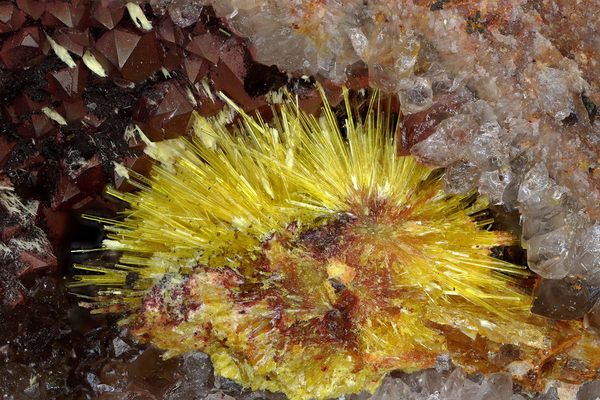Zombie Mines Haunt the Landscape
Earlier this week, we bought you an article on new and inventive uses for old mines. Part two in the series looks at what happens when mines are left abandoned.
From salt and coal to diamonds and gold, people have been digging things out of the earth for thousands of years. Most of us can picture a mining operation – headlamps, pickaxes, maybe a narrow-gauge train – but what happens to those old mines when they cease to be productive, and the workers move on?
An abandoned mine in Sweden (photo by Magnus)
Across the U.S., there are as many as 500,000 disused mine shafts and tunnels – sometimes called “zombie mines.” The highest concentrations are in the Southwest, but old and abandoned mines can be found in every state in the country.
A fortunate few of these zombie mines may go on to new lives as asthma clinics, amusement parks or mushroom farms, but the vast majority are unsuited for such redevelopment projects.
These permanently abandoned mining sites pose a number of dangers to the public. While precise figures on injures and deaths at abandoned mines are hard to come by, in 2005 the U.S. Mine Safety and Health Administration issued a report saying almost 150 people had died in recreational accidents at mining sites between 1999 and 2005.
Entrance to an abandoned gold mine in New Mexico (photo by Dustin Askins)
Risks range from the obvious – falls, rockslides, and cave-ins – to less visible threats, like trapped pockets of toxic or explosive gases. Then there’s the risk of plain-old getting lost in the dark, forever. In March of this year, an intoxicated Irish man fell to his death at an old mine shaft being operated as a historical museum in Queensland, Australia.
Environmentalists are concerned about old mines as well. Mine shafts and entries provide an exit path for groundwater laden with naturally occurring heavy metals and other toxic chemicals. Toxins can also leach into groundwater supplies from mine tailings, the remnants of ore left behind after the target resource has been extracted. Other chemicals and petroleum products may have been introduced intentionally as part of mining processes, and then left behind.
Runoff from abandoned coal mining operations (photo by The Energy Library)
So who is responsible for managing these risks?
At the national level, the Mine Safety and Health Administration is responsible for establishing and enforcing safety and health standards around mines. But, for obvious reasons, their efforts are mainly focused on active sites.
Mines located on private property are the responsibility of the landowner. But many zombie mines, especially out West, are on public lands controlled by the National Park Service or the Bureau of Land Management.
Entrance to an abandoned gold mine in Big Bear, CA (photo by Bobby Magee)
Many old mines eventually become inaccessible, either through natural processes or intentional efforts to seal them off.
Without maintenance, older mines are susceptible to natural destruction through collapse and flooding. As shoring timbers or other supports decay, cave-ins can permanently block access to all or part of the mine. Most mines of any significant depth are beneath the water table as well, and require constant pumping to stay dry. Once work stops and the pumps are turned off, these mines will begin to flood from the bottom up, blocking access.
A flooded coal mine (photo by Gerry Thomasen)
Where nature hasn’t done the job already, private and public landowners often take steps to block access to old mines. Some put up chain-link fencing or locked gates over known entrances. Others go as far as intentionally caving in the entire mine or mine entrances with controlled explosions. Another option is “capping” or “plugging” the mine—permanently covering the entrances with concrete or other durable materials.
But, where many people see a threat to public safety, others see an opportunity to explore an unfamiliar environment and have a good time.
In addition to the adventurous children and stray hikers who sometimes end up injured on old mining sites, there are groups of enthusiasts like the California Association of Cave and Mine Explorers, who intentionally seek out old mines for recreation. Despite efforts to render these old mines safer, many remain unguarded and accessible (if not always legally) to the public.
They call their sport “mine exploring,” and climb, hike, map, and photograph their finds to share with friends. It has much in common with spelunking (also known as caving) in terms of technique and equipment, but with the added danger of man-made hazards.
A company called Iron Miners has turned mine exploration into a business. The company’s experienced miners and geologists investigate abandoned sites with the goal of finding unexcavated gold and reopening them as working mines.
But not everyone is excited about the prospect of zombie mines coming back to life. In some cases these old mines can restart operations without an updated environmental review — potentially skirting regulations passed after the mine’s initial approval.
There is no consistent nationwide plan or policy for dealing with our half-a-million zombie mines. Efforts to address the issue will probably continue on a piecemeal basis, with moves to block access often in reaction to a well-publicized accident.
In the meantime, if you want to have a look at one, here is a list of guided tours of old mines all across the United States.
Exploration of an abandoned mine (photo by Denis O’Donovan)


















Follow us on Twitter to get the latest on the world's hidden wonders.
Like us on Facebook to get the latest on the world's hidden wonders.
Follow us on Twitter Like us on Facebook